Furniture as art: the work of Eileen Gray
Published in 20th-century / Contemporary History, Features, Issue 3 (May/June 2010), Volume 18Early life
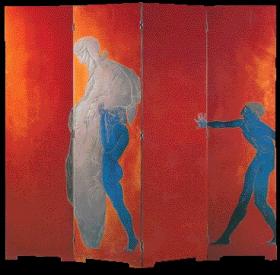
‘Le Destin’—a four-panel lacquered screen, inspired by a drawing reputed to be of a madman incarcerated in La Salpetrière hospital—was Eileen Gray’s first sale in 1914. It made auction history 58 years later when bought by Yves Saint Laurent for
Eileen Gray was born Kathleen Eileen Moray Smith near Enniscorthy, Co. Wexford, on 9 August 1878. She was the youngest of five children. The family changed their name to Gray in 1893, after her mother, Lady Eveleen Pounden, claimed her title, Baroness Gray. Her father, James MacLaren Smith, was a Scottish landscape painter. Her parents’ marriage broke up when she was eleven and her father left Ireland to live and paint in Europe. Although Eileen spent time with him on painting expeditions, she missed him desperately and transferred her love for him to her home, Brownswood, outside Enniscorthy. Within a few years that too was taken from her. When her sister Ethel married Lord Lindsay’s son, he instigated a mock-Tudor modernisation of Brownswood. Eileen was outraged, and it was suggested that she and her mother should move to the family townhouse in Kensington. She never returned to live in Brownswood. In London she attended the Slade School of Fine Art, where she was unimpressed with both her own artistic ability and the ability of the teachers.
Her father died in 1900, and in the same year her brother was killed in the Boer War. Her visit to the 1900 L’Exposition Universelle began her love affair with Paris and her fascination by the new and innovative. She was particularly taken with the Palace of Electricity’s display of 7,000 light bulbs and the exhibits of motorcars and aeroplanes, determining not only to drive but also to fly. In 1903 she moved to Paris to attend art courses at Académie Julian and the Académie Colarossi.
Lacquer to be her medium
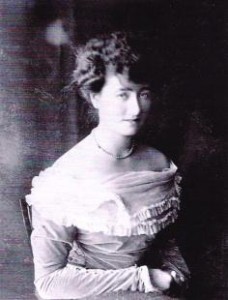
Gray as a young woman in Paris in the early 1900s (above). Within a few years she had adopted a more ‘modern’ look (below).
On a return visit to London, she came across Charles Dean’s lacquerwork studio in Soho and was so intrigued by the process that she persuaded him to take her on as an apprentice. She had found the creative medium that would bring her international recognition. Back in Paris, she bought a four-room apartment in a gracious mansion particular at 21 rue Bonaparte in Saint-Germain-des-Prés and hired Heloise Dany, the maid who remained with her for more than six decades. She shingled her hair, did away with her wardrobe of Edwardian clothes and ordered modern outfits from the top couturiers. Her nails were manicured and she wore only hand-made silk underwear.
Determined to make lacquering her métier, she convinced Seizo Sugawara to give her lessons. Sugawara-san from Japan was a master in lacquerwork who had also come to Paris for the 1900 Exposition and, like her, became enchanted with the city and stayed on. Lacquering is a difficult skill, but Eileen set up a workshop in her apartment; using her bathroom to provide the necessary humidity, she painstakingly learned how to put on up to 30 layers of lacquer, allow several days’ drying time, rub down each coat with a pumice stone and the flat of her palm, knowing that any imperfection could mean starting again from the beginning. When she contracted lacquer disease, a hard-to-heal rash, she dismissed it as little more than a minor inconvenience but was highly excited at creating a blue lacquer, something that Charles Dean had told her was impossible.
‘Le Destin’
In 1910 she opened a lacquer workshop with Sugawara a few streets away from her apartment. She honed her lacquering skills on small pieces and panels but dreamed of creating an allegorical work. After much searching, she was inspired by a drawing, reputed to be of a madman incarcerated in La Salpetrière hospital, to create the four-panel screen which she titled ‘Le Destin’ and which made her name as an internationally renowned artist.
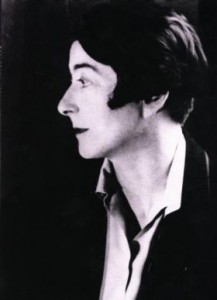 While she was reserved and shunned club life, she was part of a creative English upper-class circle who had settled in Paris. Her particular friends were Kathleen Bruce, the sculptress who became Lady Scott, wife of explorer Robert Scott; Evelyn Wyld, who oversaw her rug-making operation; and Jessie Gavin, her lesbian lover, who on occasions dressed in a false moustache, corduroys and a Norfolk jacket, saying, ‘I can take you places you can’t go unaccompanied by a man!’ With the purchase of ‘Le Destin’, Jacques Doucet became Eileen’s first customer. He was a well-known collector of artefacts and one of the foremost couturiers of the time. At his insistence, Gray signed and dated it—‘Gray 1914’. It is one of her few signed pieces. In 1917 an article on Eileen Gray’s work appeared in English Vogue, titled ‘An Artist in Lacquer’: ‘She stands alone, unique, the champion of a singularly free method of expression’.
While she was reserved and shunned club life, she was part of a creative English upper-class circle who had settled in Paris. Her particular friends were Kathleen Bruce, the sculptress who became Lady Scott, wife of explorer Robert Scott; Evelyn Wyld, who oversaw her rug-making operation; and Jessie Gavin, her lesbian lover, who on occasions dressed in a false moustache, corduroys and a Norfolk jacket, saying, ‘I can take you places you can’t go unaccompanied by a man!’ With the purchase of ‘Le Destin’, Jacques Doucet became Eileen’s first customer. He was a well-known collector of artefacts and one of the foremost couturiers of the time. At his insistence, Gray signed and dated it—‘Gray 1914’. It is one of her few signed pieces. In 1917 an article on Eileen Gray’s work appeared in English Vogue, titled ‘An Artist in Lacquer’: ‘She stands alone, unique, the champion of a singularly free method of expression’.
Her first interior was for Mrs Mathieu Lévy, a wealthy boutique-owner and milliner. Fees were not an issue as Gray had a considerable private income, and she chose projects for their interest rather than for their payment. In her hands the apartment became an atmospheric haven, with a muted colour scheme and a sculptural use of space. She created screens of lacquered brick, the Dragon chair, sausage-like Bibendum chairs and the Pirogue day bed, resembling a seashell. A 1920 issue of Harper’s Bazaar describes the apartment as ‘thoroughly modern although there is much feeling for the antique’.
Revival of interest in her work
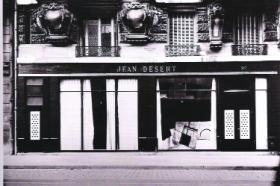
Gray’s Jean Désert Gallery, which opened on the rue du Faubourg in 1922 with the aim of showcasing the best of crafts, became a fashionable meeting place for the beau monde, although they were slow to spend their money.
Gray believed that ‘there is a path which leads upwards and there is a path which leads downwards. Both are one and the same.’ After years of living in semi-obscurity, Robert Walker, an American collector, became interested in her lacquerwork and was instrumental in initiating its wider appraisal. But it was that Paris auction of 1972, when Yves Saint Laurent bought ‘Le Destin’, that provided the momentum for the revival of interest in her career. The first retrospective exhibition of her work, titled ‘Eileen Gray: Pioneer of Design’, was held in London in 1972, and that initiated the Dublin showing which took place the following year. The RIAI marked the occasion by awarding her an honorary fellowship when she was 95 years of age. The National Museum of Ireland has a permanent exhibition of her work in the Collins Barracks site.
When Eileen Gray died on 31 October 1976, she left nine buildings and some 45 projects, as well as her maid and a stray cat which in a whimsical moment she had named Abelard. She is buried in the Père Lachaise cemetery in Paris, but because her family omitted to pay the licence fee her grave is not identifiable.
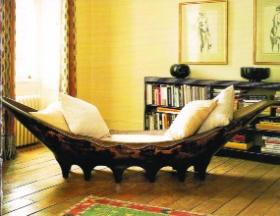
Gray’s first interior was for Mrs Mathieu Lévy, a wealthy boutique-owner and milliner, and included this Pirogue day bed. A 1920 issue of Harper’s Bazaar described the apartment as ‘thoroughly modern although there is much feeling for the antique’.
And her beloved E.1027? While researching Time & Destiny, my novel based on her life, I visited Roquebrune, hoping to view the house. But Renaud Barrès, the architect in charge at the time, refused permission, and I had to content myself with looking in from outside. Two years later, after giving a talk on her life in the Princess Grace Irish Library, Monaco, I received an official invitation. By then E.1027 was in the care of Conservatoire du Litteral, a French organisation dedicated to the protection of valuable resources—in this case Le Corbusier’s murals rather than Gray’s design, although the place still reverberates with her belief that ‘a house should be a man’s shell, his extension, his growth, his spiritual glow’. While the estimated €850,000 refurbishment work remains true to the original design, it incorporates best modern building practice. The architect in charge is now Pierre-Antoine Gattier, who oversees historical monuments in France and is the author of several works on the subject. The completion date is on target for June 2010.
After Badovici’s death in 1956, Le Corbusier built a two-storey hostel overlooking E.1027—he had already built his famous Cabanon in 1952—and dedicated himself to the preservation of his murals. When he died in 1965 (of a heart attack after his morning swim), the footpath serving the area was designated Promenade Le Corbusier. Eileen Gray’s reputation had yet to be resurrected. HI
Patricia O’Reilly’s latest novel, A type of beauty, the story of Kathleen Newton (1854–1882), will be published in June 2010 by Cape Press.
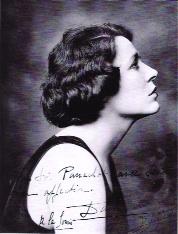
Marisa Damia, Gray’s great love in the 1920s, was the daughter of a gendarme and a nightclub singer. They drove up and down the boulevards of Paris with Damia’s pet panther sitting on the back seat of Gray’s roadster.
Further reading:
P. Adams, Eileen Gray: her life and work (London, 2009).
P. Garner, Eileen Gray (Cologne, 2006).
P. O’Reilly, Time & Destiny (Dublin, 2003).
P. Rowlands, Eileen Gray: compact design portfolio(London, 2002).
















